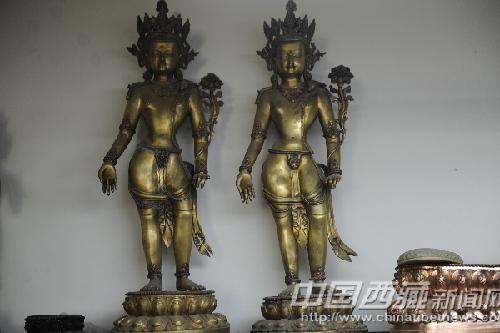Source:China Tibet Online 2015-01-31

Norbu Dondrup, the 26-year-old teacher of the "Ga" style Buddha statue casting, and his works. [Photo/Chinatibetnews]
The "Ga" style Buddha statue casting with a three to four hundred years history is prevalent in Qamdo, Garz, and Khampa area in the Tibet-Sichuan provincial border region.
The craftsmanship of "Ga" style Buddha statue casting came into being with the "SholdoPalgang" age, which refers to the Tibetan Buddhist instruments production base run by the local government on the foot of the Potala Palace in the 17th and 18th century. Though, it is influenced by the Kashmir, Nepalean, Indian and Han style Buddha statue making styles, it keeps its own style and unique complex manufacture craftsmanship.
In a classroom of the Tibet SholdoPalgang traditional craftsmanship school, a 26-year-old teacher, Norbu Dondrup, is introducing the casting and forging process of making the "Ga" style Buddha statue.

Buddha statues made by Norbu Dondrup. [Photo/Chinatibetnews]
"Different from the machine-manufactured statues, our statues have various expressions and figures and are all made by hand. Besides, we use 100 percent brass or bronze as the raw material. During the casting process, oxygen welding plays a crucial role, with which we can also make big Buddha statues." He said.
Nowadays, there are some 50 craftsmen doing this business. The traditional craftsmanship isn't as popular as before due to the high cost, expensive tuition, long time learning and unpromising employment.
Recalling his ten years' learning of the "Ga" style Buddha statue casting, Norbu Dondrup noted the hardships.

Buddha statues made by Norbu Dondrup. [Photo/Chinatibetnews]
"I was formally apprenticed to a master when I was 15. The first three years, I was almost his servant, doing all the laundry and cooking. I was not paid. After those three years, he began to teach me the skill."
Now, it takes three to four years to learn the skill. Norbu said many young people today did not have the patience and it's difficult to make both ends meet by this craftsmanship, which was his biggest concern.
Yet, he is still optimistic with his seven disciples. He believed that they would become masters.
"They are different from me. They learn Mandarin, English and other cultural courses besides Buddha statue casting. They will leave Tibet and get in the outside world to make a difference." Norbu Dondrup said.